Sustainable Cultural Innovation Practice: Heritage Education in Universities and Creative Inheritance of Intangible Cultural Heritage Craft
Abstract
:1. Introduction
1.1. Research on Methodology of ICH Educational Protection
1.2. Heritage Education Promotes Cultural Evolution
1.3. The Mechanism and Path of Intangible Cultural Heritage Protection
2. Materials and Methods
2.1. Study Design
2.2. Innovative Practice Project for College Students in Summer Vacation: Investigate She Township and Inherit She Nationality Craft
2.3. Questionnaire Survey on Cultural Heritage Consumption
3. Results
3.1. Descriptive Statistics of the Questionnaire
3.2. AMOS Model Fitness Analysis
4. Discussion
4.1. The Mediating Effect of ‘Local of Heritage Value’ on ‘Cultural Identity’
- (1)
- The total effect value of ICT on CI was 0.446, the indirect effect value was 0.114, the mediating interval [0.246,0.415] did not include 0, the p-value was 0.006, and the mediating effect was established.
- (2)
- The total effect value of HV on CI was 0.309, the mediating interval [0.234,0.400] did not include 0, the p-value was 0.002, p < 0.05, and the mediating effect was established.
- (3)
- The direct effect of ICT on HV is 0.367, and the direct effect of HV on CI is 0.309, indicating that the direct effect is significant. ICT→HV→CI has a partial mediating effect.
4.2. ‘Culture Education’ Promotes Identification of ‘Heritage of Local Value’
4.3. Sustainable Intangible Cultural Heritage Education
5. Conclusions
5.1. Cultural Reflection: Handicraft and Memory
5.2. University and Intangible Cultural Heritage
5.3. Research Contribution
Author Contributions
Funding
Institutional Review Board Statement
Informed Consent Statement
Data Availability Statement
Conflicts of Interest
Appendix A
| Keywords | Number of Articles |
| Intangible cultural heritage + ICH | 1858 + 235 |
| Intangible cultural heritage safeguarding + ICH safeguarding | 457 + 188 |
| ICH inheritance + Inheritance and Development + Protection and Inheritance + inheritance and development + Inheritance research + Inheritance and Protection + living inheritance + Intangible Cultural Heritage inheritance | 270 + 56 + 175 + 83 + 148 + 76 + 92 + 134 |
| Inheritors + ICH inheritors | 126 + 64 |
| ICH culture | 343 |
| Sports Intangible Cultural Heritage + ICH project + “ICH” dance | 104 + 80 + 84 |
| Local colleges and universities + ICH school-based curriculum + Education inheritance + Talent cultivation + Higher vocational colleges | 101 + 69 + 63 + 56 + 95 |
| Strategy research | 92 |
| Productive protection | 70 |
| Museum | 65 |
| Cultural tourism integration + Intangible Cultural Heritage scenic spots + tourism development + Rural revitalization | 59 + 212 + 57 + 73 |
Appendix B
| Independent Samples Test | ||||||
| Levene’s Test for Equality of Variances | T-Test for Equality of Means | |||||
| F | Sig. | t | df | Sig. (2-Tailed) | ||
| CP1 | Equal variances assumed | 3.544 | 0.060 | −1.644 | 410 | 0.101 |
| Equal variances not assumed | −1.604 | 306.600 | 0.110 | |||
| CP2 | Equal variances assumed | 0.337 | 0.562 | −1.310 | 410 | 0.191 |
| Equal variances not assumed | −1.293 | 318.881 | 0.197 | |||
| CP3 | Equal variances assumed | 1.053 | 0.305 | −0.785 | 410 | 0.433 |
| Equal variances not assumed | −0.790 | 340.710 | 0.430 | |||
| CP4 | Equal variances assumed | 0.001 | 0.972 | −1.666 | 410 | 0.097 |
| Equal variances not assumed | −1.655 | 325.815 | 0.099 | |||
| CP5 | Equal variances assumed | 2.599 | 0.108 | −0.921 | 410 | 0.358 |
| Equal variances not assumed | −0.901 | 309.438 | 0.368 | |||
| CI1 | Equal variances assumed | 0.217 | 0.641 | −1.782 | 410 | 0.075 |
| Equal variances not assumed | −1.790 | 337.727 | 0.074 | |||
| CI2 | Equal variances assumed | 0.102 | 0.749 | −1.864 | 410 | 0.063 |
| Equal variances not assumed | −1.895 | 350.443 | 0.059 | |||
| CI3 | Equal variances assumed | 2.012 | 0.157 | −0.565 | 410 | 0.572 |
| Equal variances not assumed | −0.575 | 351.968 | 0.566 | |||
| CI4 | Equal variances assumed | 2.528 | 0.113 | −1.686 | 410 | 0.093 |
| Equal variances not assumed | −1.684 | 331.735 | 0.093 | |||
| CI5 | Equal variances assumed | 0.012 | 0.911 | −1.252 | 410 | 0.211 |
| Equal variances not assumed | −1.267 | 346.049 | 0.206 | |||
| HV1 | Equal variances assumed | 0.067 | 0.796 | 0.855 | 410 | 0.393 |
| Equal variances not assumed | 0.855 | 333.231 | 0.393 | |||
| HV2 | Equal variances assumed | 0.082 | 0.775 | −0.979 | 410 | 0.328 |
| Equal variances not assumed | −0.973 | 326.865 | 0.331 | |||
| HV3 | Equal variances assumed | 0.412 | 0.521 | −1.618 | 410 | 0.106 |
| Equal variances not assumed | −1.602 | 322.038 | 0.110 | |||
| HV4 | Equal variances assumed | 7.770 | 0.006 | −1.613 | 410 | 0.107 |
| Equal variances not assumed | −1.654 | 359.597 | 0.099 | |||
| HE1 | Equal variances assumed | 2.561 | 0.110 | −0.980 | 410 | 0.328 |
| Equal variances not assumed | −0.965 | 316.452 | 0.335 | |||
| HE2 | Equal variances assumed | 1.845 | 0.175 | −0.182 | 410 | 0.856 |
| Equal variances not assumed | −0.179 | 314.612 | 0.858 | |||
| HE3 | Equal variances assumed | 1.337 | 0.248 | −0.983 | 410 | 0.326 |
| Equal variances not assumed | −0.964 | 312.044 | 0.336 | |||
| HE4 | Equal variances assumed | 1.752 | 0.186 | −0.889 | 410 | 0.375 |
| Equal variances not assumed | −0.859 | 296.404 | 0.391 | |||
| CR1 | Equal variances assumed | 0.162 | 0.687 | −1.721 | 410 | 0.086 |
| Equal variances not assumed | −1.719 | 331.839 | 0.087 | |||
| CR2 | Equal variances assumed | 0.783 | 0.377 | −1.715 | 410 | 0.087 |
| Equal variances not assumed | −1.730 | 342.711 | 0.084 | |||
| CR3 | Equal variances assumed | 0.247 | 0.619 | −1.260 | 410 | 0.208 |
| Equal variances not assumed | −1.268 | 340.165 | 0.206 | |||
| CR4 | Equal variances assumed | 0.000 | 0.995 | −0.627 | 410 | 0.531 |
| Equal variances not assumed | −0.631 | 340.989 | 0.528 | |||
| ICT1 | Equal variances assumed | 0.593 | 0.442 | 0.153 | 410 | 0.879 |
| Equal variances not assumed | 0.154 | 344.299 | 0.878 | |||
| ICT2 | Equal variances assumed | 1.067 | 0.302 | 0.678 | 410 | 0.498 |
| Equal variances not assumed | 0.672 | 323.088 | 0.502 | |||
| ICT3 | Equal variances assumed | 0.669 | 0.414 | −0.271 | 410 | 0.786 |
| Equal variances not assumed | −0.274 | 344.492 | 0.784 | |||
| ICT4 | Equal variances assumed | 1.905 | 0.168 | −0.176 | 410 | 0.860 |
| Equal variances not assumed | −0.179 | 353.220 | 0.858 | |||
References
- UNESCO. Convention for the Safeguarding of the Intangible Cultural Heritage. Available online: https://www.unesco.org/en/legal-affairs/convention-safeguarding-intangible-cultural-heritage (accessed on 30 September 2022).
- Chinartops. Declaration on Intangible Cultural Heritage Education. Available online: http://www.chinartops.com/whct/aritcle342.html (accessed on 30 September 2022).
- Xu, Y.Y. Inheritance and Development: Reflections on the Theory and Practice of Intangible Cultural Heritage (Chinese to English); Culture and Art Publishing House: Beijing, China, 2021; pp. 120–140. [Google Scholar]
- Gao, X.K. Inheritance and Sharing: Research on the Value Evaluation of Intangible Cultural Heritage. Cult. Herit. 2020, 5, 1–8. [Google Scholar]
- Wang, Y. A Study on Cultural Identification Issues of Intangible Heritage: Taking China as An Example; Shanghai Jiaotong University Publishing: Shanghai, China, 2021; pp. 4–140. [Google Scholar]
- Zheng, R.H.; Pang, J.C. The Status Quo and Enlightenment of Korean Intangible Cultural Heritage Discipline Education (Chinese to English). Folk. Stud. 2021, 5, 21–30. [Google Scholar] [CrossRef]
- Ma, Z.Y.; Chang, G.Y. Educational Methodology and Road Exploration of Intangible Cultural Heritage Protection. Ethn. Art Stud. 2019, 6, 135–144. [Google Scholar] [CrossRef]
- Song, L. Exploration of Hong Kong’s Intangible Cultural Heritage Education from the Perspective of Critical Thinking Cultivation. Educ. Chin. After-Sch. 2022, 5, 66–76. [Google Scholar]
- Ma, Z.Y.; Chang, G.Y. Analysis on Several Problems of Intangible Cultural Heritage Research and Training in Colleges and Universities and Their Countermeasures. J. Tianjin Univ. 2022, 3, 203–211. [Google Scholar]
- Huang, J. Research on the Development of Intangible Cultural Heritage Curriculum in Colleges and Universities Based on “Systematization of Working Process”—Exemplified by Banggudong, a Form of Puxian Ballad Singing. Cult. Herit. 2020, 2, 46–53. [Google Scholar]
- Zheng, L.H.; Lu, L. The Exploration and Practice of “Cultural Heritage” Research, Inheritance, and Innovative Talent Training Mode; Soochow Cultural Heritage No. 5. Research Center for Intangible Cultural Heritage, Soochow University: Taitō: Tokyo, Japan; Shanghai Sanlian Bookstore: Shanghai, China, 2015; pp. 391–402. [Google Scholar]
- He, B.; Ma, W. Disciplinary Construction and Introspection of Intangible Cultural Heritage Education in Japanese Universities. Folk. Stud. 2021, 5, 31–38. [Google Scholar]
- Yang, Y.X.; Cheng, X.M. The consensual Innovation of Intangible Cultural Heritage: A case study of “lacquer Art +” artistic innovation practice in Fujian Province. Fujian Trib. 2021, 5, 36–44. [Google Scholar]
- Xiao, F.; Wang, H. A Research on Ways Intangible Cultural Heritage Integrated into Contemporary Life. J. Guangxi Univ. Natl. 2021, 1, 70–77. [Google Scholar]
- Ji, Z.Y.; Gao, P.C. Intangible Cultural Heritage Safeguarding and the Regional Cultural Identity. Cult. Herit. 2021, 3, 18–23. [Google Scholar]
- Wang, M. “Integration” and “Activation”: Achievements and Measurements of the creative Transformation and Innovative development of Guizhou’s Intangible Cultural Heritage. Res. Tradit. Chin. Cult. 2022, 2, 1–11, 137. [Google Scholar]
- Wang, C.Y. Exploring the Way of Intangible Cultural Heritage Education and Its Disciplinary Development through Practice: From “Research and Training Program for Intangible Cultural Heritage Inheritors in China”. Folk. Stud. 2021, 4, 41–46, 158–159. [Google Scholar]
- Zhong, Q.; Mo, J.Y. Three Dimensions of Intangible Cultural Heritage Safeguarding: Inheritance Safeguarding, Innovative Development and Participatory Communication. Cult. Herit. 2022, 4, 35–42. [Google Scholar]
- Tan, T.M.; Ou, S.J. Review and Reflection on the Research of Intangible Cultural Heritage Education of China in Recent 20 Years. J. Chongqing Univ. Arts Sci. 2021, 40, 22–34. [Google Scholar]
- An, D.M. Forming a Community with Shared Future for Mankind Based on a Community-centered Safeguarding of Intangible Cultural Heritage. Northwestern J. Ethnol. 2018, 2, 5–11. [Google Scholar]
- Yang, L.H. From “Folklore Education” to “ICH Education”: The Indigenous Practice Journey of ICH Education in China. Folk. Stud. 2021, 4, 47–58, 159. [Google Scholar]
- Wang, L.; He, N.K. Progress of Studies on the Intangible Cultural Heritage Education of China in Recent 10 Years. J. Chongqing Univ. Arts Sci. 2016, 35, 27–31. [Google Scholar]
- Song, J.H. Paradigm Construction of Intangible Cultural Heritage. Cult. Herit. 2021, 6, 21–28. [Google Scholar]
- Guo, Z. Case Study on Innovation Practice of local cultural and economic Value: The fifth part of Intangible Cultural Heritage Research in Rongshui Miao Autonomous County. Coast. Enterp. Sci. Technol. 2021, 4, 51–56. [Google Scholar]
- Liu, Y.; Matsuda, Y. Utilization of Japanese Cultural Heritage and Economic Revitalization. Cult. Herit. 2021, 2, 23–31. [Google Scholar]
- Yan, W.-J.; Chiou, S.-C. Dimensions of Customer Value for the Development of Digital Customization in the Clothing Industry. Sustainability 2020, 12, 4639. [Google Scholar] [CrossRef]
- Hunter, K. Heritage Education in the Social Studies; Clearinghouse for Social Studies/Social Science Education, Indiana University: Bloomington, Indiana, 1988. [Google Scholar]
- Lambert, C.A. Heritage Education in the Postmodern Curriculum. Master’s Thesis, University of Pennsylvania, Philadelphia, PA, USA, 1996. [Google Scholar]
- Ma, D.Y.; Ma, Z.Y. Exploration of Intangible Cultural Heritage Educational Practice in Universities Based on Experiential Learning Theory. J. Hebei Univ. Sci. Technol. 2022, 22, 104–110. [Google Scholar]
- Yan, W.-J.; Chiou, S.-C. The Safeguarding of Intangible Cultural Heritage from the Perspective of Civic Participation: The Informal Education of Chinese Embroidery Handicrafts. Sustainability 2021, 13, 4958. [Google Scholar] [CrossRef]
- iResarch. 2019 Intangible Cultural Heritage New Economy Consumption Report. Available online: https://www.iresearch.com.cn/Detail/report?id=3381&isfree=0 (accessed on 30 September 2022).
- Xie, Z.Y. The “Pseudo-crystallization” and Aesthetic Stratification of Intangible Cultural Heritage Seen from Lion-awakening Dance. Cult. Herit. 2022, 4, 43–50. [Google Scholar]
- Lin, X.Q. Holistic Protection: Value, Idea, Practice and Challenge: Some reflections on the innovation of cultural heritage protection. Fujian Trib. 2020, 12, 36–47. [Google Scholar]
- Sun, L.; Zhou, C.G. Research and practice on innovative design of creative product modeling of regional culture: Take tiger head shoes as an example. Design 2019, 3, 126–128. [Google Scholar]
- Zhang, Y. Innovative strategies of Intangible cultural Heritage Communication in the era of cultural and tourism integration: A case study of Intangible Cultural heritage protection in Fujian Province. Southeast Commun. 2021, 6, 84–86. [Google Scholar]
- Sun, C.; Chen, H.; Liao, R. Research on Incentive Mechanism and Strategy Choice for Passing on Intangible Cultural Heritage from Masters to Apprentices. Sustainability 2021, 13, 5245. [Google Scholar] [CrossRef]
- Hang, J. Possibility of establishing “handicrafts”. Art Obs. 2022, 11, 10–12. [Google Scholar]
- Qiao, X.G.; Su, H. Cultural Inheritance in the Internet Era: Thoughts on the Social Practices and Phenomenon of Intangible Cultural Heritage. Cult. Herit. 2017, 1, 4–10. [Google Scholar]
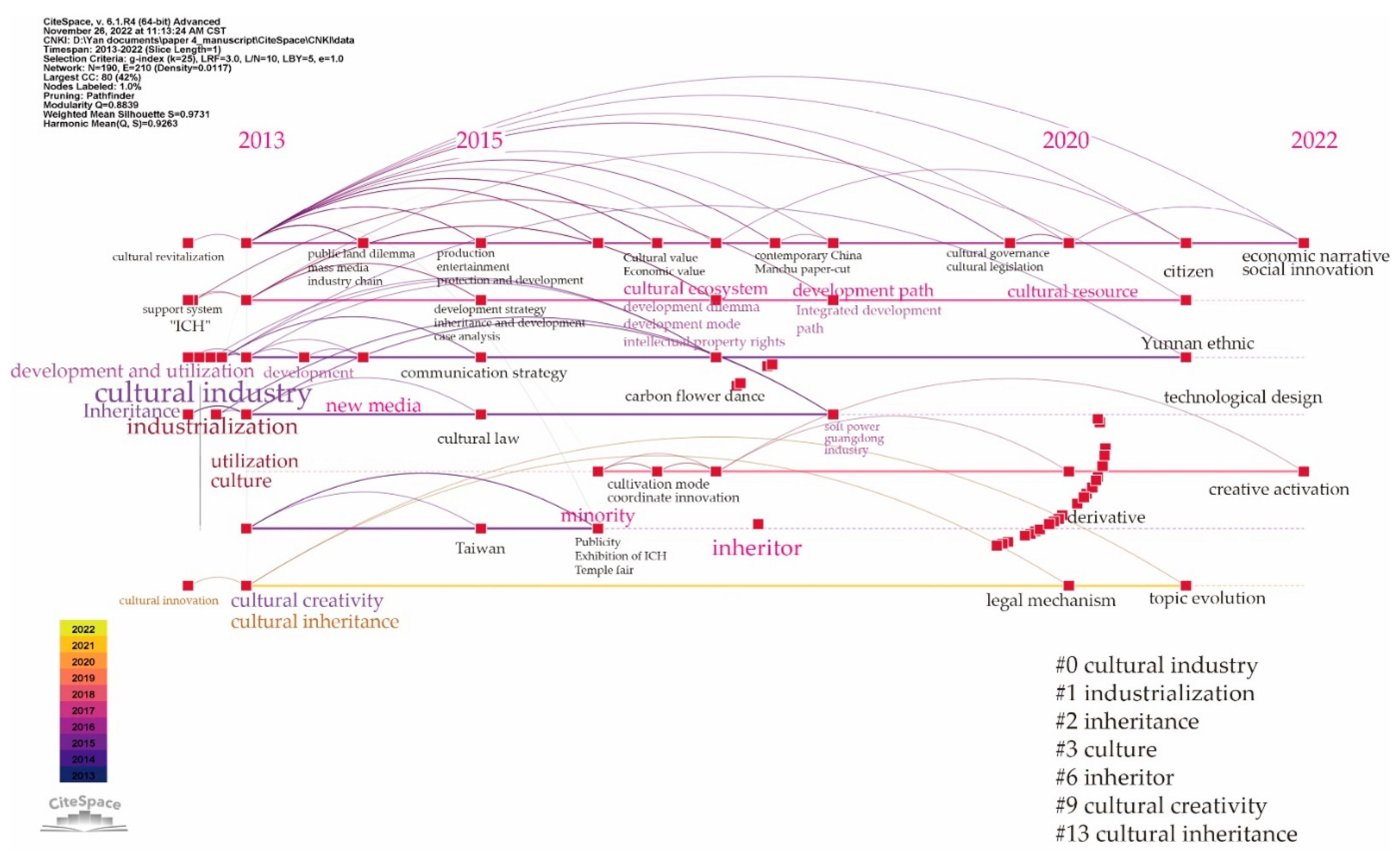
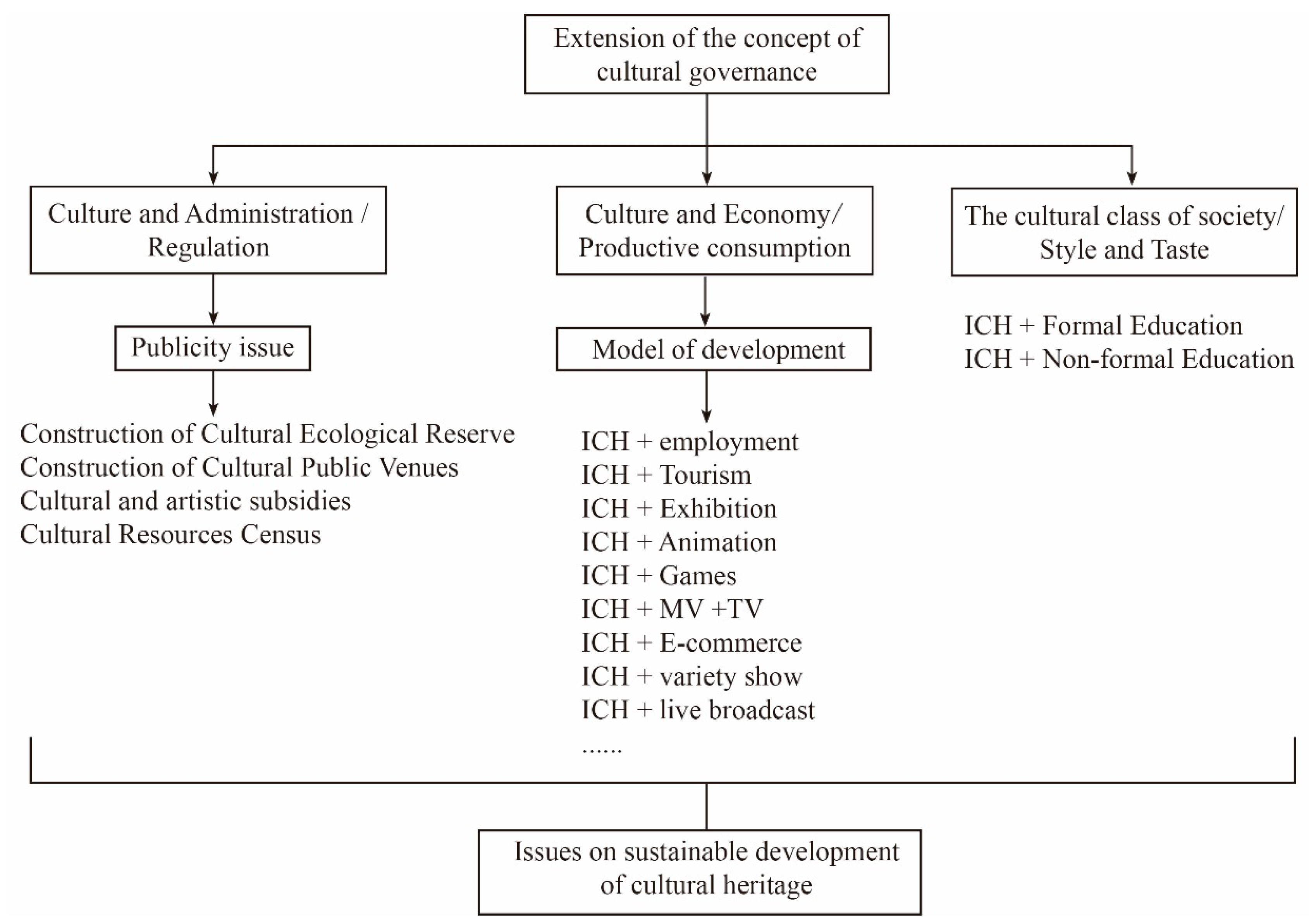
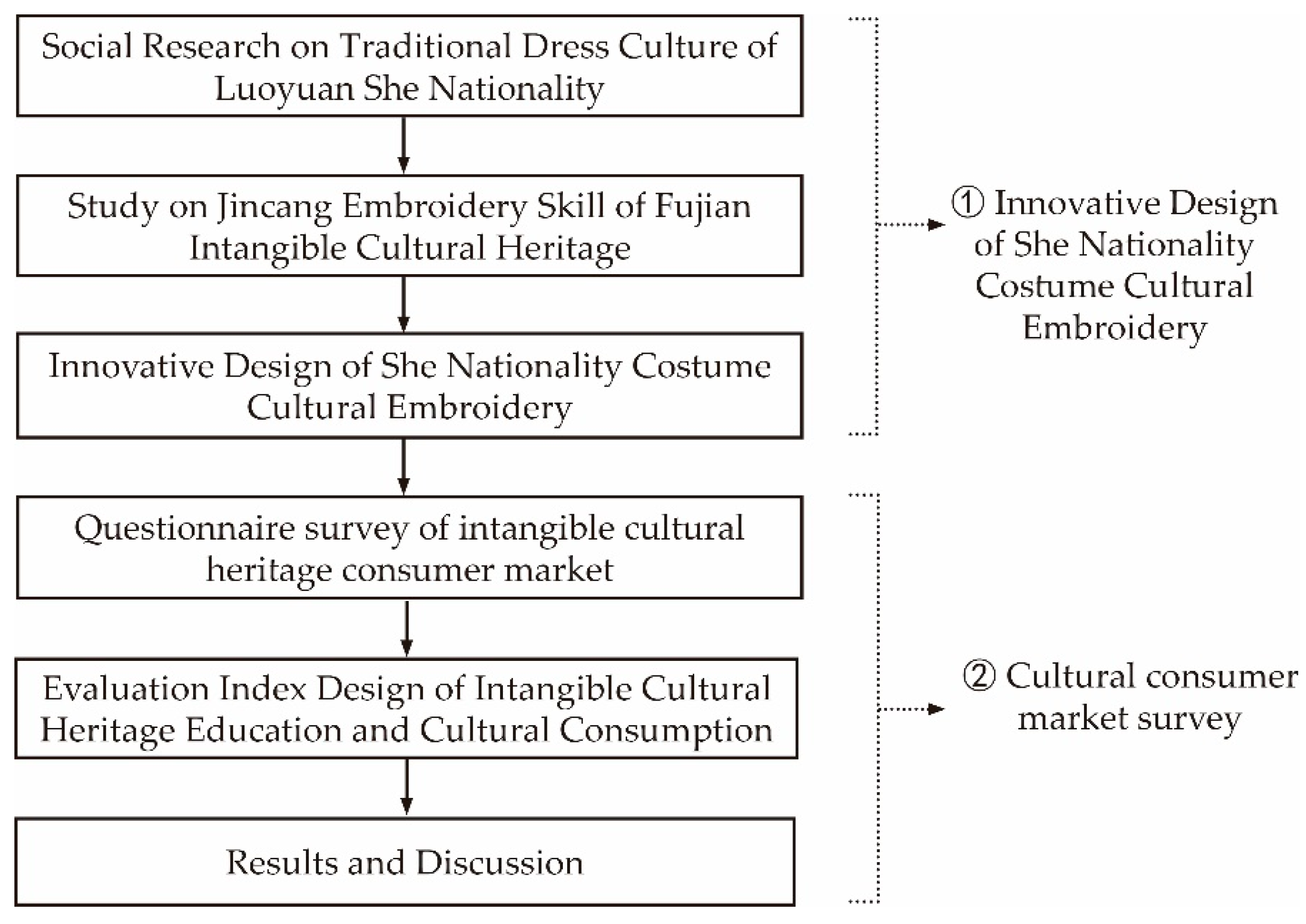
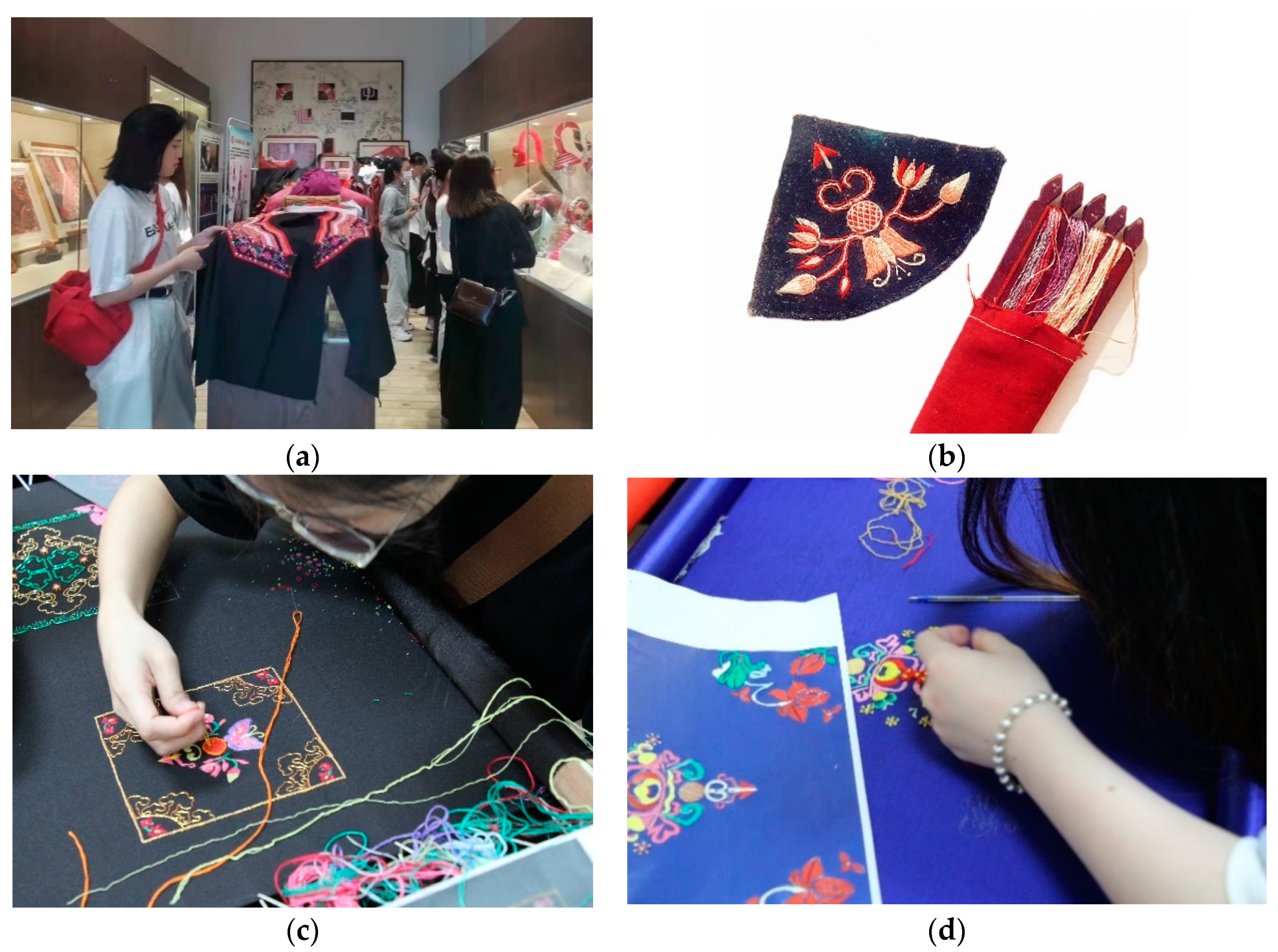

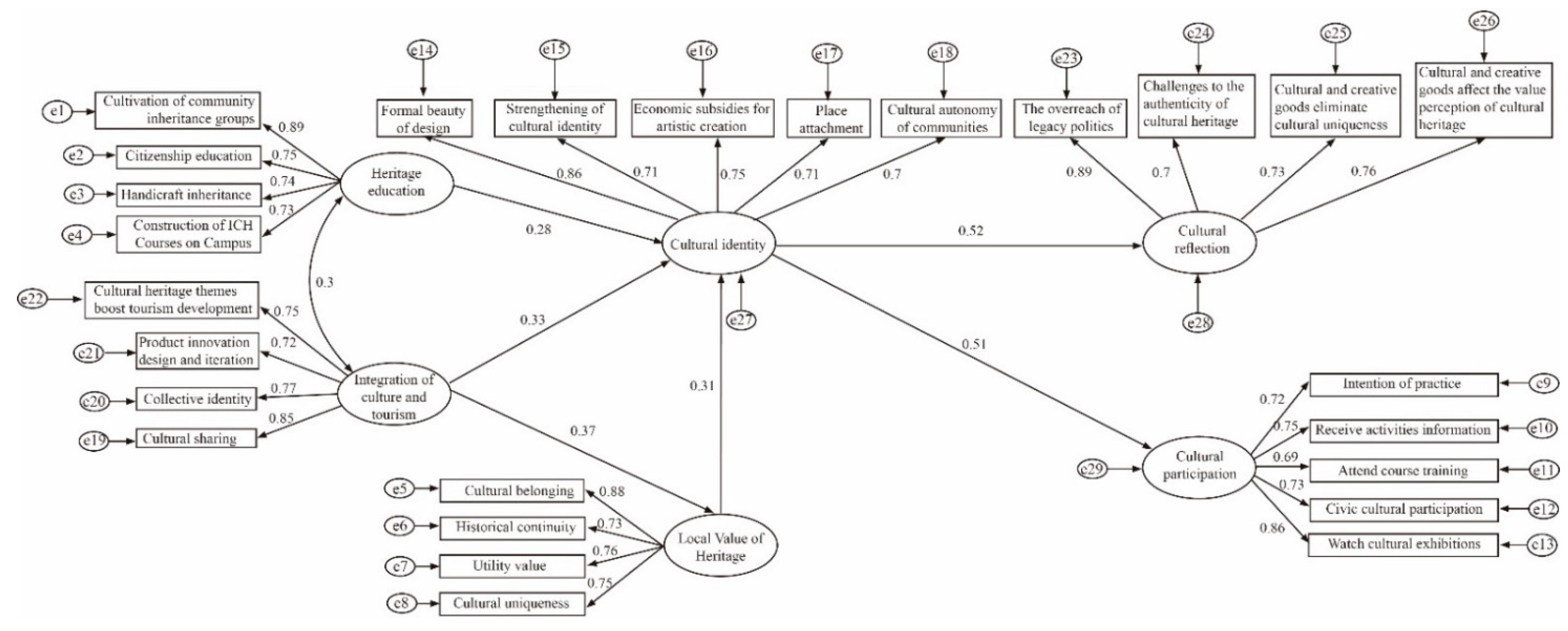

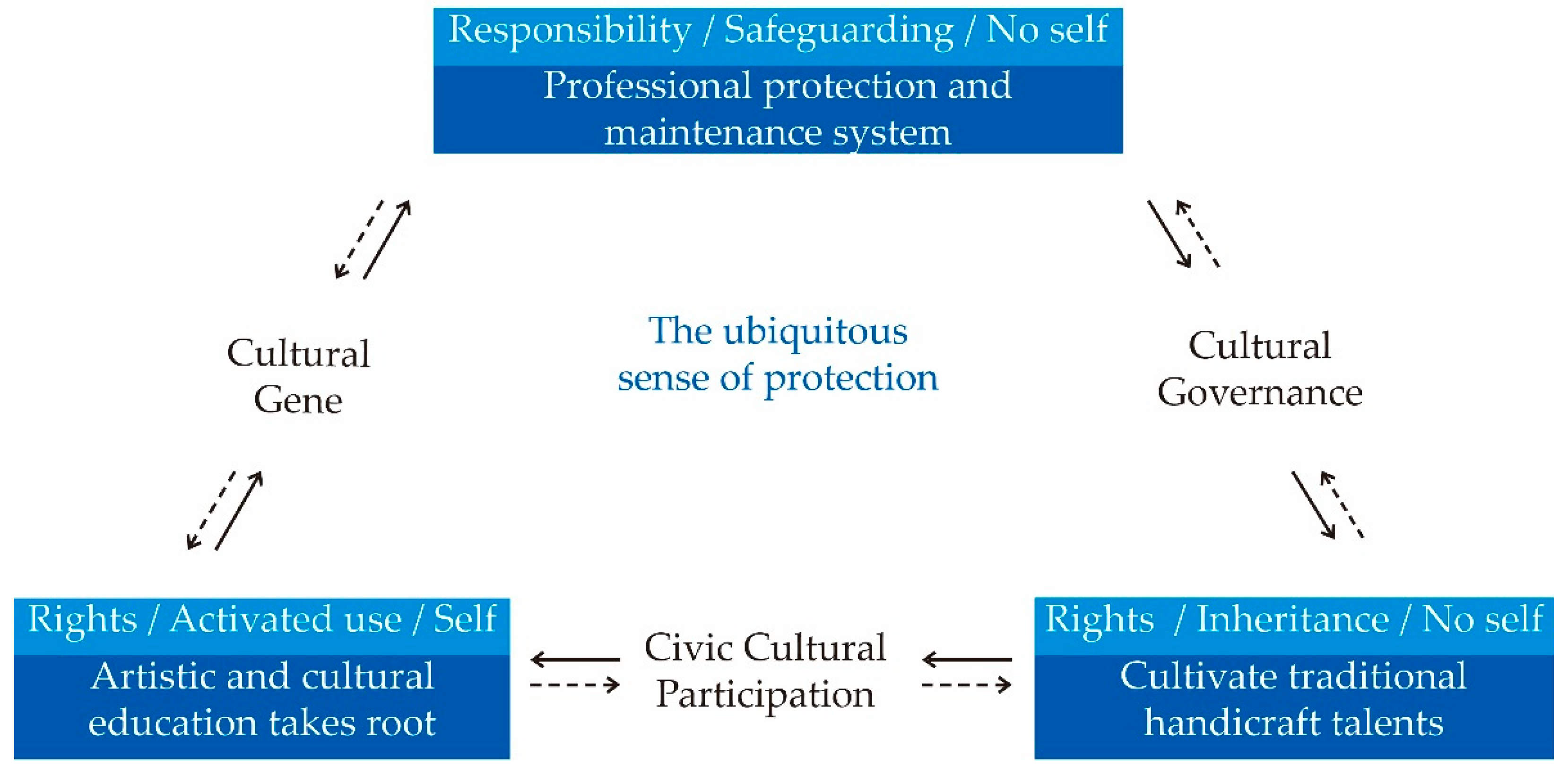
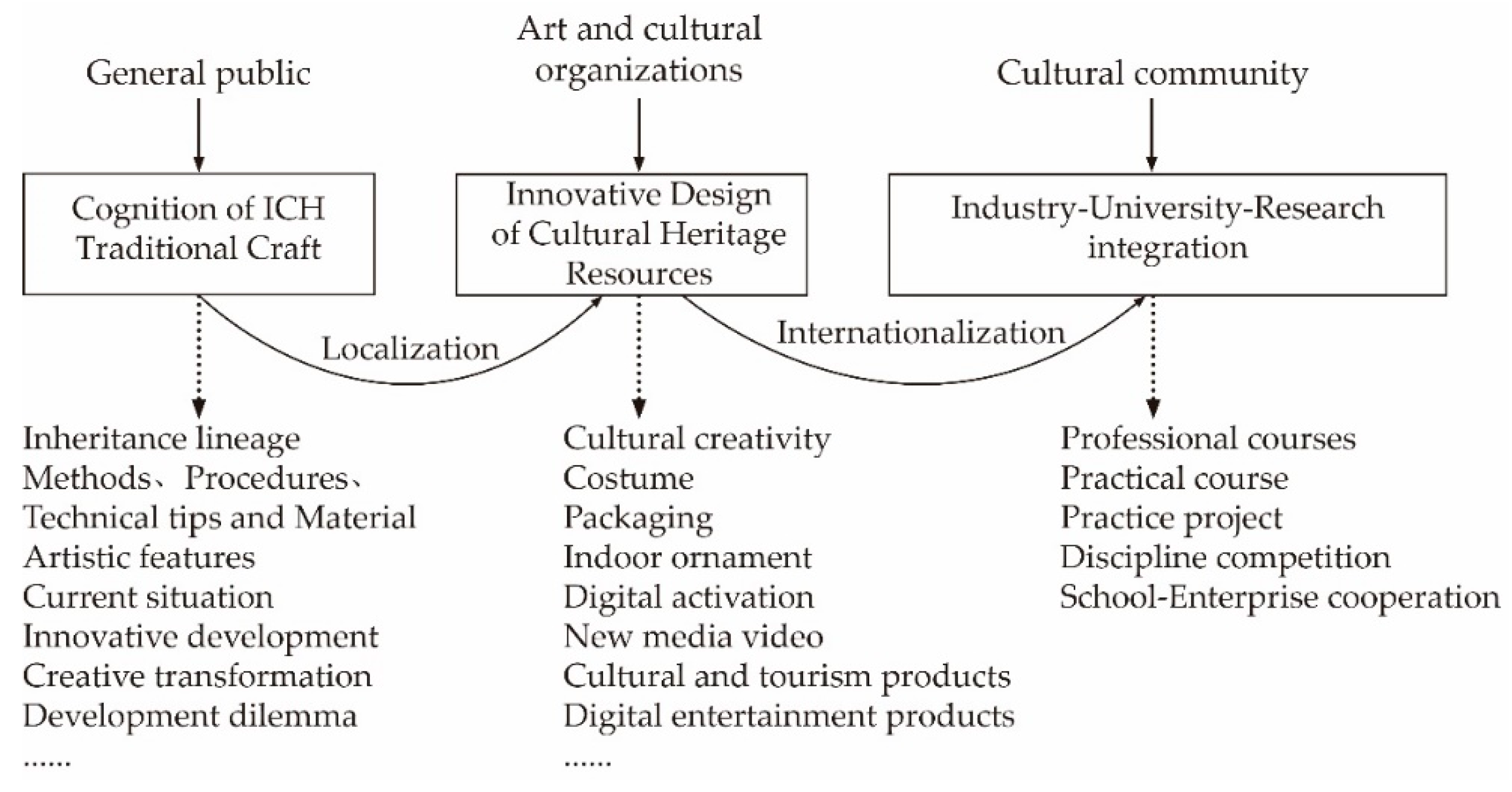
| Date | Place | Research Contents |
|---|---|---|
| 3 July 2022 | She Nationality Cultural Museum, Three quarters and Seven lanes, Fuzhou, China | Field Research on She Nationality Costume Culture |
| 4 July 2022 | She Nationality Costume Inheritance Demonstration, Luoyuan County, Fuzhou, China | Field Research on She Nationality Costume Culture |
| 5 July 2022–9 July 2022 | Quanzhou Pearl Embroidery Handicraft Inheritance Base, Quanzhou, China | Fujian Intangible Cultural Heritage Jincang Embroidery Technique, Fujian Intangible Cultural Heritage Quanzhou Bead Embroidery Technique |
| Indicators | Data Sources |
|---|---|
| Cultural identity, cultural continuity, cultural community | [1,2,15] |
| Cultural participation | [3,4,17,18] |
| Culture sharing | [4,19,20] |
| Cultural sense of belonging and local cultural perception | [21,22,23] |
| Practical value, economic value | [1,4,24,25,26] |
| Civic culture education | [21,27,28,29,30] |
| The formal beauty of design | [30,31,32] |
| Innovation in product design | [11,24,33,34,35,36] |
| No. | Content of Questionnaire Items | Number of Items |
|---|---|---|
| 0 | Definition of professional terms | / |
| 1 | Evaluation of the design value of Chinese cultural and creative products | 5 |
| 2 | Value recognition evaluation of traditional technology | 5 |
| 3 | The viewpoint and attitude of the traditional craft cultural creation product development | 5 |
| 4 | Evaluation of traditional craft inheritance and protection practices | 9 |
| 5 | Expression of value identity attitude of cultural heritage | 6 |
| 6 | Attitudes and views on the protection of cultural heritage | 6 |
| 7 | The behavioral tendency to protect and inherit traditional crafts | 5 |
| 8 | Gender | 1 |
| 9 | Age | 1 |
| NO. | Date | Name of Questionnaire | Distribution Channels | Number of Releases | Total Answers |
|---|---|---|---|---|---|
| 1 | 11 August | Formal questionnaire | Credamo data mart | 100 | 122 |
| 2 | 11 August | Formal questionnaire | Credamo data mart | 50 | 61 |
| 3 | 11 August | Formal questionnaire | Credamo data mart | 50 | 65 |
| 4 | 10 August | Formal questionnaire | Credamo data mart | 100 | 129 |
| 5 | 9 August | Formal questionnaire | Credamo data mart | 70 | 83 |
| 6 | 9 August | Formal questionnaire | Credamo data mart | 80 | 96 |
| 7 | 7 August | Formal questionnaire | Credamo data mart | 50 | 60 |
| 8 | 7 July | Pre-test questionnaire | Credamo data mart | 50 | 60 |
| Cronbach’s Alpha | Cronbach’s Alpha Based on Standardized Items | N of Items |
|---|---|---|
| 0.899 | 0.864 | 41 |
| Kaiser–Meyer–Olkin Measure of Sampling Adequacy. | 0.904 | |
| Bartlett’s Test of Sphericity | Approx. Chi-Square | 6788.560 |
| df | 325 | |
| Sig. | 0.000 | |
| Component | Variance | Factor 1 | Factor 2 | Factor 3 | Factor 4 | Factor 5 | Factor 6 |
|---|---|---|---|---|---|---|---|
| 11 Cultural participation (CP) | CP1 | 0.89 | |||||
| CP2 | 0.76 | ||||||
| CP3 | 0.75 | ||||||
| CP4 | 0.74 | ||||||
| CP5 | 0.67 | ||||||
| 2 Cultural identity (CI) | CI1 | 0.84 | |||||
| CI2 | 0.72 | ||||||
| CI3 | 0.70 | ||||||
| CI4 | 0.69 | ||||||
| CI5 | 0.64 | ||||||
| 3 Local value of heritage (HV) | HV1 | 0.88 | |||||
| HV2 | 0.78 | ||||||
| HV3 | 0.77 | ||||||
| HV4 | 0.74 | ||||||
| 4 Heritage education (HE) | HE1 | 0.89 | |||||
| HE2 | 0.80 | ||||||
| HE3 | 0.77 | ||||||
| HE4 | 0.75 | ||||||
| 5 Cultural reflection (CR) | CR1 | 0.88 | |||||
| CR2 | 0.77 | ||||||
| CR3 | 0.74 | ||||||
| CR4 | 0.74 | ||||||
| 6 Integration of culture and tourism (ICT) | ICT1 | 0.88 | |||||
| ICT2 | 0.76 | ||||||
| ICT3 | 0.75 | ||||||
| ICT4 | 0.73 | ||||||
| Initial Eigenvalues | |||||||
| Total | 8.56 | 2.27 | 1.97 | 1.91 | 1.68 | 1.45 | |
| % of Variance | 32.94 | 8.71 | 7.57 | 7.333 | 6.45 | 5.59 | |
| Cumulative % | 32.94 | 41.65 | 49.22 | 56.55 | 63.00 | 68.59 | |
| Extraction Sums of Squared Loadings | |||||||
| Total | 8.56 | 2.27 | 1.97 | 1.91 | 1.68 | 1.45 | |
| % of Variance | 32.94 | 8.71 | 7.57 | 7.333 | 6.45 | 5.59 | |
| Cumulative % | 32.94 | 41.65 | 49.22 | 56.55 | 63.00 | 68.59 | |
| Rotation Sums of Squared Loadings | |||||||
| Total | 3.35 | 3.18 | 2.89 | 2.86 | 2.79 | 2.77 | |
| % of Variance | 12.86 | 12.21 | 11.11 | 11.02 | 10.72 | 10.67 | |
| Cumulative % | 12.86 | 25.08 | 36.19 | 47.20 | 57.92 | 68.59 | |
| Item | Variable | Dimension |
|---|---|---|
| CP1 | Intention of practice | Cultural participation |
| CP2 | Receive activities information | |
| CP3 | Attend course training | |
| CP4 | Civic cultural participation | |
| CP5 | Watch cultural exhibitions | |
| CI1 | Formal beauty of design | Cultural identity |
| CI2 | Strengthening of cultural identity | |
| CI3 | Economic subsidies for artistic creation | |
| CI4 | Place attachment | |
| CI5 | Cultural autonomy of communities | |
| HV1 | Cultural belonging | Local value of heritage |
| HV2 | Historical continuity | |
| HV3 | Utility value | |
| HV4 | Cultural uniqueness | |
| HE1 | Cultivation of community inheritance groups | Heritage education |
| HE2 | Citizenship education | |
| HE3 | Handicraft inheritance | |
| HE4 | Construction of ICH courses on Campus | |
| CR1 | The overreach of legacy politics | Cultural reflection |
| CR2 | Challenges to the authenticity of cultural heritage | |
| CR3 | Cultural and creative goods eliminate cultural uniqueness | |
| CR4 | Cultural and creative goods affect the value perception of cultural heritage | |
| ICT1 | Cultural sharing | Integration of culture and tourism |
| ICT2 | A sense of common identity | |
| ICT3 | Cultural heritage themes boost tourism development | |
| ICT4 | Product innovation design and iteration |
| Component | Mean | Std. Deviation | N |
|---|---|---|---|
| CP | 3.10 | 0.92 | 500 |
| CR | 3.09 | 0.97 | 500 |
| ICT | 3.18 | 0.98 | 500 |
| CI | 3.00 | 0.89 | 500 |
| HE | 3.23 | 0.98 | 500 |
| HV | 3.07 | 0.98 | 500 |
| CP | CR | ICT | CI | HE | HV | ||
|---|---|---|---|---|---|---|---|
| CP | Pearson Correlation | 1 | 0.357 ** | 0.359 ** | 0.462 ** | 0.262 ** | 0.330 ** |
| Sig. (2-tailed) | 0 | 0 | 0 | 0 | 0 | ||
| N | 500 | 500 | 500 | 500 | 500 | 500 | |
| CR | Pearson Correlation | 0.357 ** | 1 | 0.391 ** | 0.452 ** | 0.309 ** | 0.318 ** |
| Sig. (2-tailed) | 0.000 | 0 | 0 | 0 | 0 | ||
| N | 500 | 500 | 500 | 500 | 500 | 500 | |
| ICT | Pearson Correlation | 0.359 ** | 0.391 ** | 1 | 0.446 ** | 0.279 ** | 0.336 ** |
| Sig. (2-tailed) | 0 | 0 | 0 | 0 | 0 | ||
| N | 500 | 500 | 500 | 500 | 500 | 500 | |
| CI | Pearson Correlation | 0.462 ** | 0.452 ** | 0.446 ** | 1 | 0.420 ** | 0.461 ** |
| Sig. (2-tailed) | 0 | 0 | 0 | 0 | 0 | ||
| N | 500 | 500 | 500 | 500 | 500 | 500 | |
| HE | Pearson Correlation | 0.262 ** | 0.309 ** | 0.279 ** | 0.420 ** | 1 | 0.317 ** |
| Sig. (2-tailed) | 0 | 0 | 0 | 0 | 0 | ||
| N | 500 | 500 | 500 | 500 | 500 | 500 | |
| HV | Pearson Correlation | 0.330 ** | 0.318 ** | 0.336 ** | 0.461 ** | 0.317 ** | 1 |
| Sig. (2-tailed) | 0 | 0 | 0 | 0 | 0 | ||
| N | 500 | 500 | 500 | 500 | 500 | 500 | |
| Statistical Test Quantity | Criterion or Threshold for Adaptation | Test Result Data | Model Fit Judgement |
|---|---|---|---|
| Absolute Fit Measures | |||
| RMSEA (Root Mean Square Residual) | <0.05 | 0.045 | √ |
| GFI (Goodness-of-Fit Index) | >0.90 | 0.918 | √ |
| Baseline Comparisons | |||
| NFI (Normed Fit Index) | >0.90 | 0.915 | √ |
| RFI (Relative Fit Index) | >0.90 | 0.905 | √ |
| IFI (Incremental Fit Index) | >0.90 | 0.955 | √ |
| TLI (Tucker–Lewis Coefficient) | >0.90 | 0.950 | √ |
| CFI (Comparative Fit Index) | >0.90 | 0.955 | √ |
| Parsimony-Adjusted | |||
| PGFI (Parsimony Goodness-of-Fit Index) | >0.50 | 0.764 | √ |
| PNFI (Parsimony-Adjusted NFI) | >0.50 | 0.822 | √ |
| PCFI (Parsimony-Adjusted CFI) | >0.50 | 0.858 | √ |
| CN (Critical N) | >200 | 597.956 | √ |
| CMIN/DF (Chi-Square/Degrees of Freedom) | <3.00 | 2.014 | √ |
| CAIC (Consistent Akaike’s Information Criterion) | The theoretical model value is less than the independent model value, and at the same time less than the saturated model value. | 1013.636 < 2532.327 1013.636 < 7107.889 | √ |
| Absolute Fit Measures | |||
| X2 (Chi-Square) | p > 0.05 | p = 0.000 < 0.05 Df = 288 | √ |
| RMSEA (root mean square residual) | <0.05 | 0.04 | √ |
| GFI (goodness-of-fit index) | >0.90 | 0.92 | √ |
| AGFI (adjust goodness-of-fit index) | >0.90 | 0.91 | √ |
| Baseline Comparisons | |||
| NFI (Normed fit index) | >0.90 | 0.92 | √ |
| RFI (Relative Fit Index) | >0.90 | 0.91 | √ |
| IFI (incremental fit index) | >0.90 | 0.96 | √ |
| TLI (Tucker–Lewis Coefficient) | >0.90 | 0.95 | √ |
| CFI (Comparative Fit Index) | >0.90 | 0.96 | √ |
| Parsimony-Adjusted | |||
| PGFI (parsimony goodness-of-fit index) | >0.50 | 0.755 | √ |
| PNFI (parsimony-adjusted NFI) | >0.50 | 0.811 | √ |
| PCFI (parsimony-adjusted CFI) | >0.50 | 0.846 | √ |
| CN (Critical N) | >200 | 586.47 | √ |
| CMIN/DF (Chi-Square/degrees of freedom) | <3.00 | 2.036 | √ |
| CAIC (Consistent Akaike’s Information Criterion) | The theoretical model value is less than the independent model value, and at the same time less than the saturated model value | 1040.98 < 2532.33 1040.98 < 7107.89 | √ |
| Hypothesis | Standardized Path Coefficient | Standard Error | Bias-Corrected 95%CI | p Value | Support | |
|---|---|---|---|---|---|---|
| Lower | Upper | |||||
| H1: CI←HV | 0.309 | 0.065 | 0.234 | 0.400 | 0.002 | Yes |
| H2: CP←CI | 0.51 | 0.038 | 0.432 | 0.590 | 0.003 | Yes |
| H3: CI←HE | 0.276 | 0.061 | 0.187 | 0.361 | 0.004 | Yes |
| H4: HV←ICT | 0.367 | 0.051 | 0.280 | 0.466 | 0.002 | Yes |
| H5: CI←ICT | 0.333 | 0.067 | 0.246 | 0.415 | 0.006 | Yes |
| H6: CR←CI | 0.516 | 0.052 | 0.447 | 0.591 | 0.004 | Yes |
| 95% Confidence Interval | ||||
|---|---|---|---|---|
| Estimate | BC/PC p Value | BC | PC | |
| Total Effect | ||||
| CI←ICT | 0.367 | 0.002/0.004 | 0.280~0.466 | 0.267~0.460 |
| ICT→HV | 0.458 | 0.018/0.010 | 0.360~0.555 | 0.373~0.566 |
| HE→CI | 0.276 | 0.004/0.004 | 0.187~0.361 | 0.188~0.364 |
| ICT→CI | 0.446 | 0.005/0.004 | 0.363~0.522 | 0.365~0.524 |
| HV→CI | 0.309 | 0.002/0.004 | 0.234~0.400 | 0.229~0.393 |
| HE→CR | 0.143 | 0.004/0.004 | 0.094~0.192 | 0.094~0.192 |
| ICT→CR | 0.231 | 0.004/0.004 | 0.177~0.289 | 0.177~0.291 |
| HV→CR | 0.160 | 0.003/0.004 | 0.114~0.212 | 0.113~0.211 |
| CI→CR | 0.516 | 0.004/0.004 | 0.447~0.591 | 0.447~0.591 |
| HE→CP | 0.141 | 0.002/0.004 | 0.094~0.196 | 0.091~0.193 |
| ICT→CP | 0.228 | 0.004/0.004 | 0.172~0.289 | 0.172~0.291 |
| HV→CP | 0.158 | 0.003/0.004 | 0.110~0.217 | 0.109~0.214 |
| CI→CP | 0.510 | 0.003/0.004 | 0.432~0.590 | 0.429~0.580 |
| Direct Effect | ||||
| ICT→HV | 0.367 | 0.002/0.004 | 0.280~0.466 | 0.267~0.460 |
| HE→CI | 0.276 | 0.004/0.004 | 0.187~0.361 | 0.188~0.364 |
| ICT→CI | 0.333 | 0.006/0.004 | 0.246~0.415 | 0.253~0.419 |
| HV→CI | 0.309 | 0.002/0.004 | 0.234~0.400 | 0.229~0.393 |
| CI→CR | 0.516 | 0.004/0.004 | 0.447~0.591 | 0.447~0.591 |
| CI→CP | 0.510 | 0.003/0.004 | 0.432~0.590 | 0.429~0.580 |
| Indirect Effect | ||||
| ICT→CI | 0.114 | 0.002/0.004 | 0.076~0.164 | 0.270~0.157 |
| HE→CR | 0.143 | 0.004/0.004 | 0.094~0.192 | 0.094~0.192 |
| ICT→CR | 0.231 | 0.004/0.004 | 0.177~0.289 | 0.177~0.291 |
| HV→CR | 0.16 | 0.003/0.004 | 0.114~0.212 | 0.113~0.211 |
| HE→CP | 0.141 | 0.002/0.004 | 0.094~0.196 | 0.091~0.193 |
| ICT→CP | 0.228 | 0.004/0.004 | 0.172~0.289 | 0.172~0.291 |
| HV→CP | 0.158 | 0.003/0.004 | 0.110~0.217 | 0.109~0.214 |
| Parameter | Estimate | Lower | Upper | p |
|---|---|---|---|---|
| ICT←→HE | 0.299 | 0.193 | 0.404 | 0.004 |
| Measurement Item | Initial | Extraction |
|---|---|---|
| Traditional crafts team training for local communities | 1.00 | 0.82 |
| Cultural heritage embodies social inclusion, is the medium of civic education, and has cultural and educational value | 1.00 | 0.70 |
| Inheritance of traditional production processes, methods and skills | 1.00 | 0.69 |
| Intangible cultural heritage enters the campus, and cultural education of schoolchildren and teenagers takes root | 1.00 | 0.66 |
| Professional, fair and transparent subsidy mechanism for artistic creation | 1.00 | 0.67 |
| Innovative design and continuous updating of product development | 1.00 | 0.62 |
| Scientifically plan local arts and cultural venues to facilitate public participation | 1.00 | 0.62 |
| Respect the intellectual property rights of craftsmen, protect the labour rights and interests of cultural workers, and improve the working environment of arts and culture | 1.00 | 0.50 |
| Rebuild the local art and cultural history, connect the historical memory of the land and people, and strengthen the local cultural influence | 1.00 | 0.43 |
Disclaimer/Publisher’s Note: The statements, opinions and data contained in all publications are solely those of the individual author(s) and contributor(s) and not of MDPI and/or the editor(s). MDPI and/or the editor(s) disclaim responsibility for any injury to people or property resulting from any ideas, methods, instructions or products referred to in the content. |
© 2023 by the authors. Licensee MDPI, Basel, Switzerland. This article is an open access article distributed under the terms and conditions of the Creative Commons Attribution (CC BY) license (https://creativecommons.org/licenses/by/4.0/).
Share and Cite
Yan, W.-J.; Li, K.-R. Sustainable Cultural Innovation Practice: Heritage Education in Universities and Creative Inheritance of Intangible Cultural Heritage Craft. Sustainability 2023, 15, 1194. https://doi.org/10.3390/su15021194
Yan W-J, Li K-R. Sustainable Cultural Innovation Practice: Heritage Education in Universities and Creative Inheritance of Intangible Cultural Heritage Craft. Sustainability. 2023; 15(2):1194. https://doi.org/10.3390/su15021194
Chicago/Turabian StyleYan, Wen-Jie, and Ke-Run Li. 2023. "Sustainable Cultural Innovation Practice: Heritage Education in Universities and Creative Inheritance of Intangible Cultural Heritage Craft" Sustainability 15, no. 2: 1194. https://doi.org/10.3390/su15021194
APA StyleYan, W.-J., & Li, K.-R. (2023). Sustainable Cultural Innovation Practice: Heritage Education in Universities and Creative Inheritance of Intangible Cultural Heritage Craft. Sustainability, 15(2), 1194. https://doi.org/10.3390/su15021194






